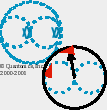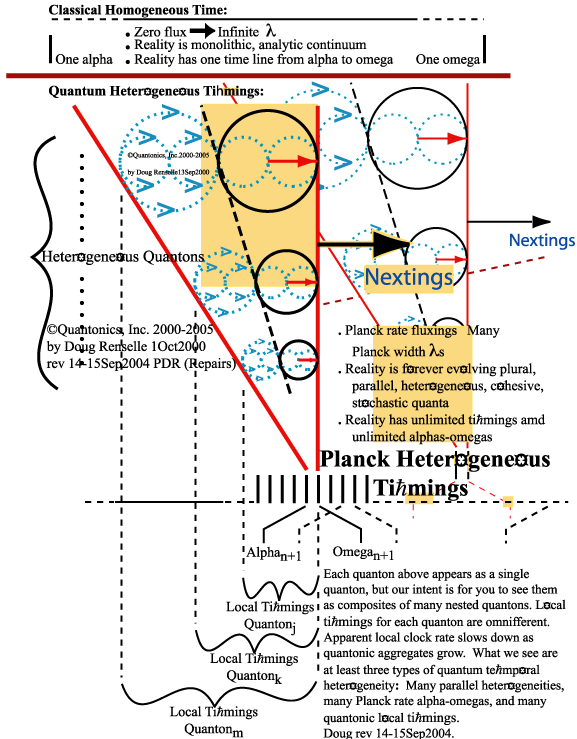Arches Art
If you're stuck in a browser frame - click here to view this same page in Quantonics!
Classical Homogeneous
Time
vis-à-vis
Quantum Heterogeneous Tihmings
Watch for additional comments
here in future.
"Doug! Damn it! How am I
to figure out what all that gobble-dee-gook above means?"
Listen, reader, we
understand your reaction. It has taken us years to get to this
point. It is n¤t easy. However, we are
attempting to make it easier and faster for YOU.
Look at our red left-leaning
V
above. Think about you...think about yourself...as one of those
quantons in our V.
Now, ask yourself, "Self,
self, of what are we made, Oh! self, of what are we made? What
are our constituents, self?"
Self's answer: "Quantons!"
Now again, ask yourself, "Self,
self, Oh! self, of what are those quantons made?"
Self's answer: "Quantons!"
So, reader, you have already
learned a great deal so far.
From a Quantonics perspective, and using QTMs, you are a quanton made of
aggregates of quantons each of which is more aggregates of quantons.
Now again, ask yourself, "Self,
how far down does this recursion of quanton aggregates go?"
Self's answer: "Superb question! Quantum science tells
us that quantum reality's smallest or least unit of action, e,
is a unit of absolute flux whose wavelength is called the
Planck lambda,  , or Planck wavelength.
It is smaller than our abilities
, or Planck wavelength.
It is smaller than our abilities
to measure it. (Modern scientific measurement can go down to scales
of ~10-19, with total scientific
bandwidth capability roughly 1022, or 73 octaves
—about half in terms of octaves, n¤t in terms
of bandwidth capacity—
of nature's whole musical score.
Compare that to a Planck length scale of ~10-43.) So
our answer is that an interim
'bottom' occurs when quantons' aggregate comstituents are all
|
ePlanck |
 |
 |
" |
Now perceptually anticipate many other you's and many
other quantons which comstitute
our multiverse.
Further comsider each of those other quantum systems having their
own "many tihmings,"
plus
many other "many quantum numbers-flux_artifacts." Now
comsider their potential and actual
"many qualitative Quantonic-quantum measurement event interrelationships."
(8Mar2001 - Doug.)
We can simplify this whole discussion by just saying,
"SOM's CTMs
synthesize quantum reality's
many tihmings into a single unitime."
SOM is consistent. It synthesizes most of its classical
concepts.
However, quantum reality is n¤t
unitemporally synthetic. It is omnitemporally real.
SOM tries to con us and it does con its objective
reality. (29Mar2001 - Doug.)
We say this another way commencing 2006,
"SOM, its CTMs, and their classical dialectic
perjure quantum reality!"
6Jan2006 - Doug.
Now reader, we can give you a glimmer of what our graphic
above means for you.
Imagine what might happen to you if you had to be capable of keeping
track of real ævæntings
in your own l¤cal physical comtext at a Planck rate of
approximately (quantum~rælatihvæ t¤ l¤cal quantum~phasæ ratæs) 1043
occurrences
per l¤cal phasicityings' quantum~tæhmp¤ral ¤mniht ræfæræncings!
6Jan2006 - Doug.
Can you imagine your extreme overload?
(In Quantonics, we think this may be a quantum exegetic for autism!
Also comsider what that means if it is an exegetic!
It means humans have intrinsic extended
sensory capabilities which we do n¤t use or have n¤t
yet
learned to use. You also may wish to view our Stairs
as Perceived by our Quantum Stages on this particular topic.)
At scales between our interim Planck bottom (no pun) and our l¤cal
physical comtext, many other
quantonic aggregates, e.g. atoms, have l¤cal tihmings
which are slower than a Planck clock rate, but still much too
fast for us.
Finally, reader you
should be able to see what our graphic above shows. Each 'level'
of quantons has its own l¤cal
tihmings base bandwidth. In a manner
of speaking, "We cann¤t feel, see, or sense tihmings' rates outside our temporal
bandwidth."
To see this more vividly, think about your body's cells. They
are working at some rates outside your bandwidth.
Too, when they undergo apoptosis
and rebirth, y-our senses are normally wholly unaware. Now
think about
y-our bodies' atoms and their electrons. Obviously, we have no
inkling of those tihmings' scale
of ævæntingss
even though
they are happening on vast scales of ~1027 atoms and
above
when you consider atoms' constituent 'electron,' 'nucleon,' and
quark quantons.
Omnifferent quanton 'levels' of aggregates have omnifferent tihmings' bandwidths, or omnifferent
l¤cal tihmings. You
should now be
able to understand why we say quantum tihmings
are heter¤gene¤us, amd emphatically n¤t classically
homogeneous-unitemporal.
Mae-wan Ho talks about humans' sensory capabilities
in terms of their uses of available real bandwidth.
Read her book for more: the
Rainbow and the Worm. (Search for 'octave.')
We discuss this topic briefly in our review of William James'
Some Problems of Philosophy.
See our Chapter I review, page
22 Comments.
Our above graphic arises from our attempts to view
quantum tihmings in a more novel
light. As you can see classical time is homogeneous, one time,
unilogical time. By comparison, quantum tihmings
aræ heterogeneous, many tihmings,
omnilogical tihmings or paralogical
tihmings. Our intuemes for
this novel plural tihmings view come
from studying these authors: Robert M. Pirsig, William
James Sidis, Mae-wan Ho, William James,
Henri Louis Bergson, and Sin-Itiro Tomonaga's recollection of
P.A.M. Dirac's work on a "many times" version of quantum
science.
Robert M. Pirsig had a large influence early in our
process of discovery. He introduced us to a meme of
"many truths" in "many contexts." See his
books in our Recommended
Reading and his SODV
paper here on our site.
Then Mae-wan Ho gave us our first whiff of passé classical
time as
"an infinitely divisible homogeneous quantity," and
showed us a di(omni)fferent, more
quantum intueme
of quantum tihmings
as "an indivisible heterogeneous quality." See our Famous MoQites-Bergson for more.
From there, we found James' marvelous comments on more
novel quantumesque pluralism and its absolute
"flux" vis-à-vis obsolete objective-materialist
monism. Next, we took Mae-wan's suggestions and pursued
Henri Louis Bergson's works. Our diagrams above find us having
finished a review of Bergson's An
Introduction to Metaphysics,
and near an end of our review of Chapter I of his Creative
Evolution. Interested readers should watch for Chapter
I's debut
on our site starting 9Oct2000. We will try to complete one chapter
each week thereafter.
Bergson's remarks (catalyzed
by Mae-wan's urgings) affected much of our graphic work above.
Our sincere thanks to Mae-wan Ho for her prescient work in her
the Rainbow
and the Worm. Too,
we must acknowledge Rhett Savage for his site h is for
h-bar
(we have lost this link and will attempt to restore it when we
can: http://www.reed.edu/~rsavage/index.html),
where we first discovered Mae-wan's work.
And, reader, you might imagine
our absolute thrill in reading Tomonaga's The Story of Spin,
Lesson 6, to discover Dirac's many times wave function! That was,
for us, spine tingling.
A huge impetus for us to understand a novel meme of
heterogeneous tihmings as replacement
for
an old, obsolete, classical Platonic-Aristotelian-Newtonian idea-concept of homogeneous
time
is our work on William James Sidis' The Animate and the Inanimate
(AIA). William Sidis was about
12 years old when William James transitioned back to isobeing.
Nine years later Bill Sidis wrote
AIA. We wonder how much of William James' Some
Problems of Philosophy Bill Sidis knew about. We think
there is enough suggestive evidence there for a great mind like
Sidis' to commence a fundamental grasp
of heterogeneous tihmings. If we
reviewed his book assuming that Sidis' view of time was classically
homogeneous when, indeed, it was quantumesquely heterogeneous—well,
you can see what a terrible
result we might have hewn. Sadly, our efforts to learn about heterogeneous
tihmings are delaying our pending
AIA review at least two years! But our results will be
much better and you, our audience, will benefit greatly.
We think our graphic (even though it has extreme 2D
limitations) offers a good beginning to those
of you who want to learn and innovate more about many tihmings and heterogeneous tihmings and plural tihmings.
And if it does, we may have saved you our many tihmings
of work to arrive at this juncture.
Adjunct to our effort here we
are working on a groundwork paper for our WJS AIA review,
which you may wish to read here titled,
Classical vis-à-vis
Quantonic Time.
Hope you find this helpful!
Thanks for reading, amd "Many Tihmings
To You,"
 Doug, 1Oct2000.
©Quantonics, Inc., 2000-2011 — Rev.
23Apr2009 PDR — Created: 1Oct2000 PDR
Doug, 1Oct2000.
©Quantonics, Inc., 2000-2011 — Rev.
23Apr2009 PDR — Created: 1Oct2000 PDR
(2Oct2000 rev - Repair typos. Added 'Reader...self'
help section at top, to make graph interpretation easier.)
(11Oct2000 rev - Correct sublink of Stairs as Perceived by
our Quantum Stage to 'Autism.')
(11Oct2000 rev - Add link to our review of Bergson's Creative
Evolution.)
(17Oct2000 rev - Add 'nucleon' as another type of atomic quanton
constituent.)
(7Nov2000 rev - Add link to our WJS AIA paper on Classical
vis-à-vis Quantonic Time.)
(16Nov2000 rev - Add anchor and red color emphasis to paragraph
on temporal bandwidth.)
(8Mar2001 rev - Add new red text. Alter 'context,' to 'comtext'
and replace 'idea' and 'concept' with quantumese.)
(8Mar2001 rev - Pluralize quantum 'times' where apropos.)
(29Mar2001 rev - Add remarks on SOM's synthesis of time.)
(31Mar2001 rev - Change nonclassical uses of 'new' and 'not' to
'novel' and 'n¤t.')
(14Nov2001 rev - Add link to our temporal bandwidth paragraph
above. Extend commennts there. Disable Rhett's link.)
(6Dec2001 rev - Add top of page frame-breaker.)
(13Feb2002 rev - Change Planck rate units from temporal to spatial.)
(7Sep2002 rev - Quantum Remediate page top graphic. Remediate
quantum comtextual terms as needed.)
(14Jun2004 rev - Swap 'lambda' GIF for 'lambda' symbol font.)
(14-15Sep2004 rev - Remove table height and width constraints.
Reset legacy red text.)
(6Jan2006 rev - Add red text and links. Add 'Cellular Apoptosis'
link.)
(23Ap2009 rev - Change some fonts to gifs. Routine maintenance.
Make page current.)
Arches Art


